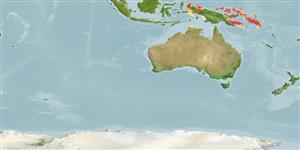>
Clupeiformes (Herrings) >
Spratelloididae (Small round herrings)
Etymology: Spratelloides: Old German, sprotte (1611) = a small fish, Clupea sp. + Greek, suffix, oides = similar to (Ref. 45335).
Issue
The species in the genera Spratelloides Bleeker, 1851 and Jenkinsia Jordan & Evermann, 1896 should most probably be assigned to a separated family from Clupeidae and Dussumieriidae (Lavoué, pers. comm., July 2013). See a preliminary analysis in Lavoué et al. (2013: Ref. 93878).
Environment: milieu / climate zone / depth range / distribution range
Ecologia
marino; distribuzione batimetrica 0 - 50 m (Ref. 188). Tropical; 2°N - 12°S, 130°E - 164°E (Ref. 188)
Western Central Pacific: Solomon Islands, Papua New Guinea, and off Irian Jaya.
Size / Peso / Age
Maturity: Lm ? range ? - ? cm
Max length : 6.0 cm SL maschio/sesso non determinato; (Ref. 188)
Spine dorsali (totale): 0; Raggi dorsali molli (totale): 12-13; Spine anali 0; Raggi anali molli: 11 - 12. Distinguished from other species mainly by the silver band on the flanks which fades anteriorly (at about tips of pectoral fins). Maxilla toothed, triangular pre-maxillae, 2 supra-maxillae, second supra-maxilla asymmetrical (lower part larger than upper); vertical striae on scales not meeting at center; W-shaped pelvic scute.
Usually an inshore schooling species. More data needed. Used as bait in the tuna fishery. Found in coastal waters, sometimes forming large active schools at surface near reefs (Ref 90102).
Whitehead, P.J.P., 1985. FAO Species Catalogue. Vol. 7. Clupeoid fishes of the world (suborder Clupeoidei). An annotated and illustrated catalogue of the herrings, sardines, pilchards, sprats, shads, anchovies and wolf-herrings. FAO Fish. Synop. 125(7/1):1-303. Rome: FAO. (Ref. 188)
IUCN Red List Status (Ref. 130435)
Threat to humans
Harmless
Human uses
Pesca: pesca di sussistenza; esca: usually
Informazioni ulteriori
BibliografiaAcquacolturaProfilo di acquacolturaVarietàGeneticaElectrophoresesEreditarietàMalattieElaborazioneNutrientsMass conversion
CollaboratoriImmaginiStamps, Coins Misc.SuoniCiguateraVelocitàModalità di nuotoArea branchialeOtolithsCervelliVista
Strumenti
Special reports
Download XML
Fonti Internet
Estimates based on models
Preferred temperature (Ref.
123201): 28.2 - 29.1, mean 28.8 °C (based on 16 cells).
Phylogenetic diversity index (Ref.
82804): PD
50 = 0.5625 [Uniqueness, from 0.5 = low to 2.0 = high].
Bayesian length-weight: a=0.00513 (0.00296 - 0.00889), b=3.15 (2.99 - 3.31), in cm total length, based on LWR estimates for this species & (Sub)family-body (Ref.
93245).
Trophic level (Ref.
69278): 3.0 ±0.0 se; based on diet studies.
Resilienza (Ref.
120179): Alto, tempo minimo di raddoppiamento della popolazione meno di 15 mesi (K=4.30-8.90; tm=0.3; Fec=887).
Fishing Vulnerability (Ref.
59153): Low vulnerability (10 of 100).
Nutrients (Ref.
124155): Calcium = 2530 [213, 133,283] mg/100g; Iron = 41.7 [3.8, 409.3] mg/100g; Protein = 18.8 [14.4, 23.1] %; Omega3 = 0.227 [0.004, 13.207] g/100g; Selenium = 1810 [23, 107,595] μg/100g; VitaminA = 0.46 [0.00, 53.86] μg/100g; Zinc = 33.4 [4.1, 187.8] mg/100g (wet weight);
